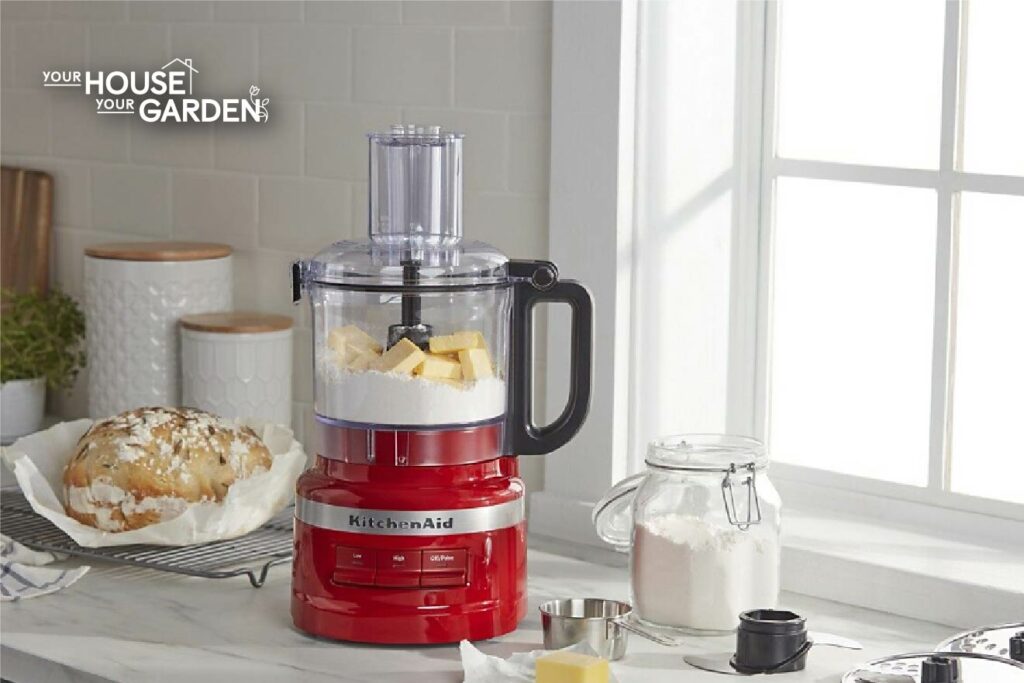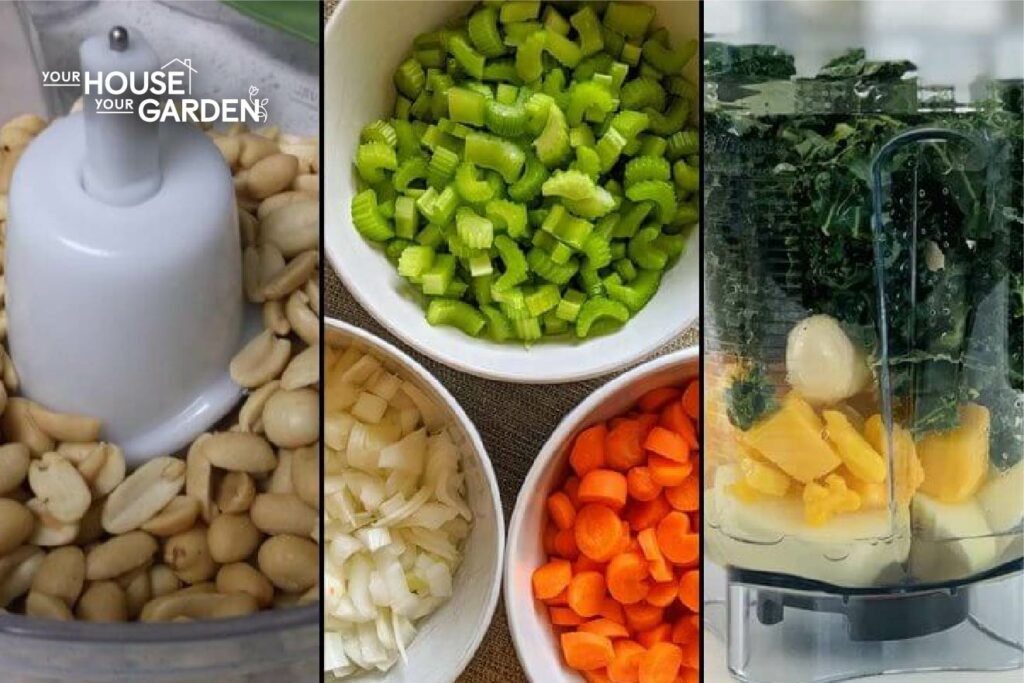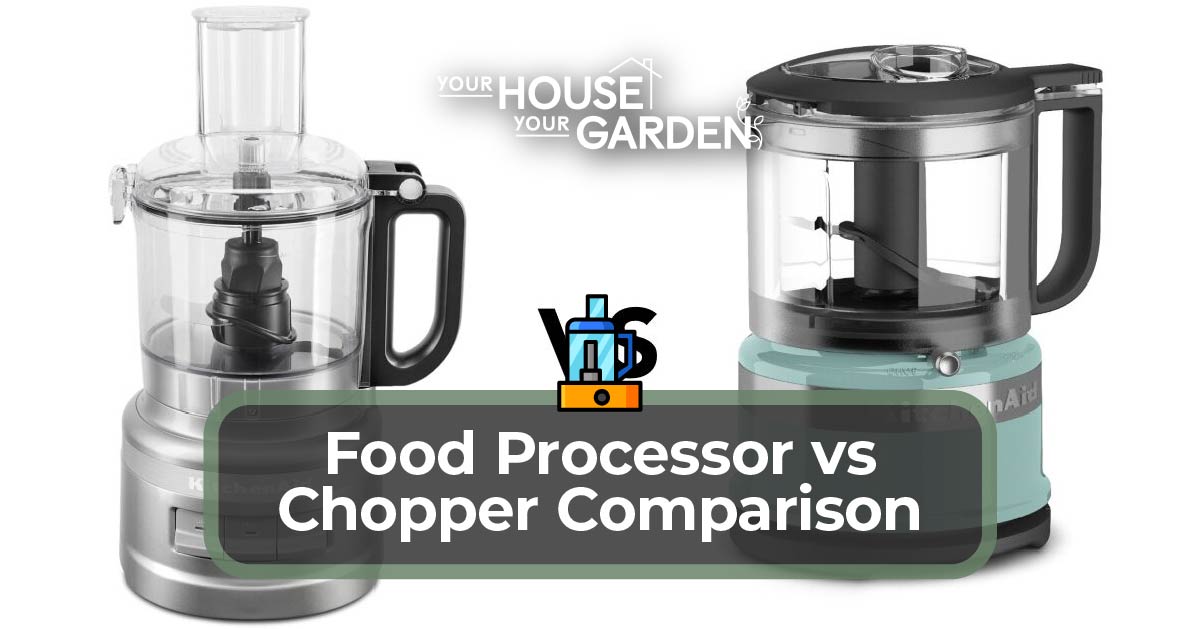Some of the most efficient and time-saving tools in kitchens today are the food processors and choppers.
Unlike blenders that prepare soupy meals, both food processors and choppers are used in preparing more textured meals. Despite their similarities, these appliances differ in several ways as we’ll see in this food processor vs chopper debate.
To help you make the right purchasing decision, we’ll delve into the food chopper vs food processor debate.
Let’s find out the differences between a food processor and a chopper.
Differences between A Food Processor vs A Chopper
The major difference between a food processor and a chopper is in their design.
Food processors are large kitchen appliances that come with interchangeable blades and discs that make them versatile in performing multiple cooking tasks like chopping, kneading, shredding, grating, pureeing, and mixing, etc. While a food chopper is a smaller (often manual) appliance with a fixed blade for handling fewer kitchen tasks such as chopping, shredding, and mixing smaller batches of food.
The second main difference between a food processor and a food chopper is in their capacity.
A food processor has a larger capacity for processing large batches of food. The standard bowl sizes of food processors range from 6 to 16 cups. Food choppers, on the other hand, have smaller bowls that can only hold between 1 and 5 cups of a small quantity of food.
To help you make the right purchasing decision for your food processing needs, we’ll explore these appliances individually.
What is a food processor? A food processor is a countertop appliance for cutting fruits, vegetables, and other ingredients.
Food processors are versatile in their operations because they come with an assortment of interchangeable blades and discs for performing a wide variety of tasks. They are designed for chopping, dicing, grating, mixing, slicing, shredding, and pureeing vegetables, fruits, herbs, and other items. Some food processors allow you to grate cheese and knead dough for bread or pizza.
Food processors have powerful motors that can handle heavy-duty tasks: so when you have a lot of vegetables that will be too labor-intensive, the appliance to use is the food processor. They have the capacity to prepare around 6 to 16 cups of food in one go. Their versatility also means they can replace many other kitchen utensils.
What is a food chopper? A food chopper is a compact kitchen tool for processing small quantities of food. Because they’re also great at preparing dry foods, they’re also referred to as mini food processors.
The blades of a food chopper are not detachable, making the appliance limited in its functions. But you can crunch peanuts, chop veggies, dice meat, and slice fruits. One of the most appealing features of using choppers is the control the appliance gives you – you can determine the cut size and shape of your items. While there are electrical food choppers, the most common choppers are manually operated. But they’re good for saving the time you’d rather spend using a knife.
Food choppers can also do some laborious food processing: albeit, on a small scale. So a food chopper isn’t ideal for avid cooks that cook a lot or homes with more than three members. Also, a food chopper can’t perform heavy-duty tasks as the blades aren’t powerful enough.
Superiorities of a food processor to a food chopper
The benefits of owning a food processor over a food chopper are its versatility, larger capacity, and performance. Food processors can multitask and handle a wider variety of tasks than food choppers. Plus their larger capacities and performance mean they can cater to the needs of large families or the busy kitchens of home chefs.
More versatility
When compared to a chopper, a food processor is designed to perform multiple food preparation tasks.
A food processor can perform labor-intensive tasks like chopping, slicing, shredding, grating, and emulsifying vegetables, herbs, fruits, and other ingredients. In addition, you can knead dough and whip cake batter. Food processors come with an assortment of blades and discs for performing a wide range of tasks. Their multi-functionality in preparing different recipes in one appliance makes them replace some other kitchen appliances and utensils. Here are the other use cases of food processors.
Food choppers, on the other hand, come with fixed blades for preparing food – this makes them limited in their operation. Also, they can’t puree dips, knead dough, whip batter, and perform a range of other tasks that you can do with your food processor.
Larger capacity
One of the benefits of having a food processor rather than a food chopper is that food processors have larger bowls for preparing larger quantities of food.
Most standard food processors can hold around 6 to 16 cups of food which is enough to feed more than four people. Food choppers are smaller appliances for processing smaller quantities of food. They can hold between 1 and 5 cups of food, which can only feed a household of no more than three people.
Performs heavy-duty tasks
In comparison with food choppers, food processors are built with more powerful motors to carry out heavy-duty tasks.
So when you want to perform heavy-duty tasks like processing a large volume of fruits and veggies for a large family or guests, a food processor is the best appliance to use. Food processors are also time-savers when it comes to processing large volumes of food. Choppers aren’t efficient at performing heavy-duty tasks, plus their blades aren’t optimized for cutting through very tough items.
Superiorities of a food chopper to a food processor
The benefits of owning a food chopper over a food processor are their compact size and cheaper cost. For as little as $15, you can get a reliable tool to process your meals without sacrificing much space on the kitchen counter.
Space saver
If you have a small kitchen where you cook for a few people (not more than three), using a food chopper will be ideal. Food choppers are lightweight, efficient compact appliances that take up only a little space on the counter. They’re also easy to store. Food processors have large bowls and engines run by powerful motors that make them look bulky on a small kitchen counter. Also, storing them is not so easy due to their bulky sizes.
Cheaper cost
When compared to a food chopper, food processors are more expensive because of their power, versatility, and capacity.
Food choppers cost around $15 to $54, while food processors cost between $60 and $700.
Ease of cleaning
Both a food processor and a chopper are dishwasher-safe and easy to clean: however, choppers have a smaller build and fewer working parts, making them easier to clean.

Food Differences between A Food Processor and A Chopper
Food processors are versatile appliances that can perform tasks such as slicing, chopping, shredding, grinding, mixing, pureeing, kneading, and grating a wide variety of items. However, not all foods can be processed in a food processor – the same goes for food choppers. Here are the foods you can and can’t process in food processors and choppers.
What foods can be processed in a food processor?
You can process the following foods in a food processor;
- Salsa: pineapple and mango salsa, etc.
- Vegetables: onions, winter squash, garlic, celery, carrots, Brussels
- Butter and other textured spreads
- Meat
- Salmon
- Nuts
- Textured dips: hummus, avocado dip, roasted eggplant
- Dough: bread, cake, biscuit, pizza, and pie
- Cheese
- Baby food
- Chickpea
- Bread crumbs
- Cookies
- Pesto
- Cream
- Homemade mayonnaise
- Fruits: bananas, almonds,
- Potatoes
- Oats
You shouldn’t put the following foods in a food processor;
- Bones
- Hot or boiling items
- Tough meat cuts
- Ice
- Very runny foods
- Gelatin
- Fruit peels
You can find how to use a food processor here.
What foods can be processed in a food chopper?
You can process the following foods in a food chopper;
- Herbs
- Vegetables: onions, garlic, carrots, celery, broccoli, green peppers
- Nuts
- Salsa
- Pesto
- Avocado
- Dressings
- Bread crumbs
- Baby food
- Nuts
- Fruits
Using a food processor and a chopper
Food processors can perform both the smaller routine tasks that food choppers can do and lots more. Since food choppers are often referred to as small versions of food processors, it’s not advisable to have both appliances in your kitchen.

What are the instances where a food processor and a food chopper can be used together?
You can use a food processor and a food chopper if you do a lot of cooking daily. Using your food processor for heavy-duty tasks and your chopper for lighter tasks will preserve the lifespan of your food processor.
What are the instances a food processor and a food chopper should never be used together?
Both a food processor and a food chopper are designed to process our everyday foods, with food processors performing a wider variety of tasks. If you cook for less than three people or don’t cook often, a chopper will suffice as it can cater to the needs of a few people. But if you cook for a larger family of more than three members, getting a food processor will be the best option.
Food Processor vs Food Chopper Purchasing Tips
While food processors and choppers handle similar tasks, they have different significance in the kitchen. Answering the following questions will help you decide which of these appliances will be suitable for your living condition.
What are the types of food processors and choppers?
There are three types of food processors: batch bowl, continuous feed, and combination food processors.
Batch bowl food processors have their blades or discs inside their bowls. They’re designed for residential use. The blades are interchangeable, and the bowls can hold between 6 and 16 cups of ingredients. However, the bowls of batch bowl food processors are limited in the volume of food they can prepare, and you’ll have to pour their content at the end of each batch.
Continuous feed food processors are designed for preparing larger batches of food. Instead of a bowl, they come with a feed tube that allows you to continually add ingredients to the blades so you can collect the processed ingredients in any container of your choice.
Combination food processors combine the functionality of a batch bowl food processor and a continuous feed food processor to save space on the kitchen counter.
There are five types of food choppers: fruit and vegetable choppers, tomato slicers, spiral slicers, French fry choppers, meat choppers, and electric choppers.
Fruit and vegetable choppers are the most common food choppers in homes. They have manual presses for cubing fruits and slicing veggies to your desired sizes.
Tomato slicers are designed for slicing tomatoes uniformly. Spiral turning slicers are great for chopping salads and other ingredients into long thin strands. French fry choppers are great for cutting French fries into the perfect uniform shapes. Meat choppers are great for grinding meat to prepare delicious sausages and burgers. And electric food choppers are often regarded as mini food processors because of their smaller capacity and types of blades.
What’s the capacity of food processors and choppers?
If you have a family of more than three members, a food processor will be the ideal tool for your kitchen as it can process 6 to 16 cups of food at a time. Food choppers are ideal for smaller families of two to three members as they have capacities of not more than 5 cups.
How much do a food processor and chopper cost?
Food processors are more expensive than choppers because of the vast number of kitchen tasks they can handle. Prices for a food processor for domestic use can reach up to $500 while you can get a chopper for as little as $15.
Best Brands for Food Processors
The five best brands making the best food processors are KitchenAid, Cuisinart, Ninja, Breville, and Hamilton Beach.
KitchenAid
KitchenAid is our top brand for the best food processor maker. Their models are characterized by their quiet operation and having large capacities for holding large volumes of food. KitchenAid food processors are also durable and efficient in chopping ingredients to the perfect sizes and with consistency.
Cuisinart
One of the best brands making the best food processors is Cuisinart. Generally, their kitchen appliances are affordable without compromising on quality. Their models come with powerful motors and large bowls for processing large batches of food. They’re also quiet in operation.
Ninja
If you’re looking for some of the most powerful and durable food processors, look no further than Ninja. The brand makes some of the most reliable kitchen appliances. Their bowls are also large enough to cater to the needs of large families. They’re also versatile in the foods they can process. Although some of their units take up too much space on the kitchen counter.
Breville
Breville is another popular name making some of the most durable food processors. Their units are loved for their versatility and ease of use. They’re also powerful in slicing through tough foods and handling heavy-duty tasks.
Hamilton Beach
Hamilton Beach makes some of the best budget-friendly kitchen appliances. Their food processors are mid-priced and highly efficient in delivering their duties. Their units are very versatile and powerful. However, some of their models are noisy.
Best Brands for Food Choppers
The five best brands making the best food choppers are KitchenAid, Cuisinart, Kuhn Rikon, OXO, and Ninja.

